Epson EH-TW7400 Review
A superb home cinema projector with extensive features for a competitive price
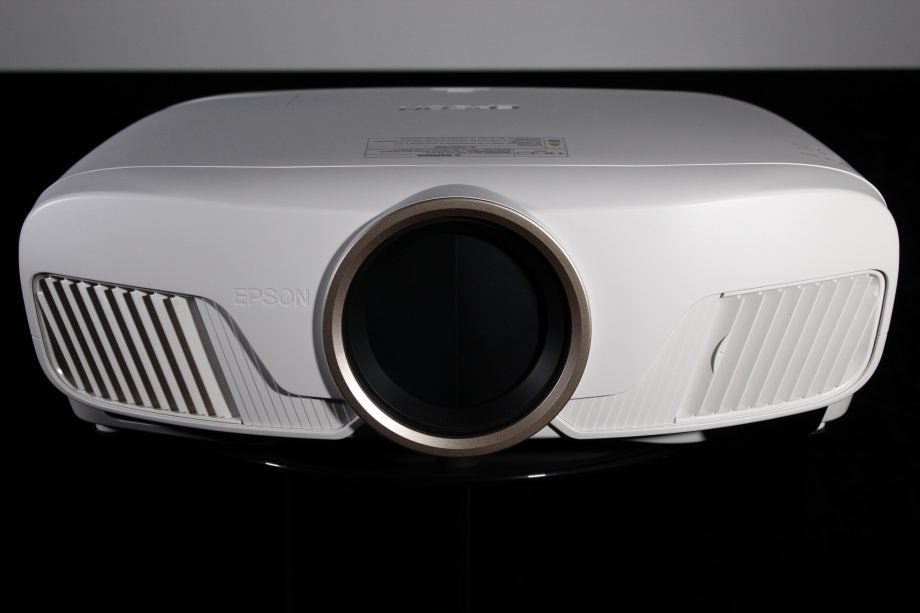

Verdict
This impressively specified home cinema projector delivers a great performance for a knock-out price
Pros
- Excellent picture quality
- Accurate images
- Extensive features
- Low input lag
- Great price
Cons
- Poor blacks and shadow detail
- Not bright enough for true HDR
Availability
- UKRRP: £2199
- USAunavailable
- EuropeRRP: €2499
- Canadaunavailable
- Australiaunavailable
Key Features
- 4K Enhancement
- 3-chip LCD projector
Introduction
The Epson EH-TW7400 is the latest entry-level model in the manufacturer’s home cinema range of projectors – which means it’s aimed at those with a dedicated room, rather than someone who plans to set up their projector only occasionally for a movie night or the big game.
The EH-TW7400 isn’t native 4K but can accept an Ultra HD signal, and it boasts a host of higher-end features including support for 3D and HDR. However, this three-chip LCD projector is available at a price that approaches the budget end of the projector market, making it a potential bargain.
Design
The Epson EH-TW7400 uses exactly the same chassis as the rest of the company’s home cinema range, which means it’s much bigger than the lifestyle projectors that tend to dominate the sub-£2000 end of the market.
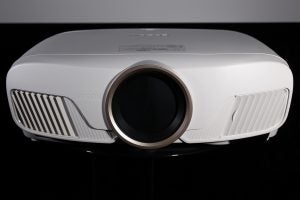
The design is based around a central lens, with air vents on either side. The chassis has curved edges, and is made of a hardened plastic. Build quality is excellent, and the EH-TW7400 comes in a lifestyle-friendly white finish.
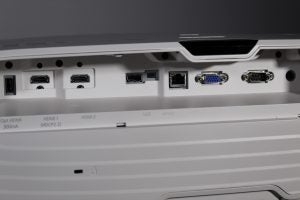
All the connections are housed in a recess at the rear, where you’ll find two HDMI inputs, one of which supports 4K, 10-bit HDR, and HDCP 2.2. There’s also a VGA connector, two USB ports, a LAN port, a 12V trigger and an RS232 connector for serial control.
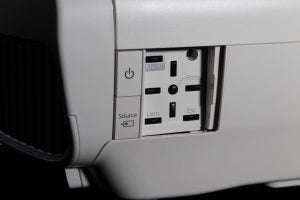
Unusually for a projector at this price point, there’s a motorised lens cover that protects the Epson from dust. On the right-hand side, as you face the projector, you’ll see a sliding panel behind which you’ll find some basic controls.
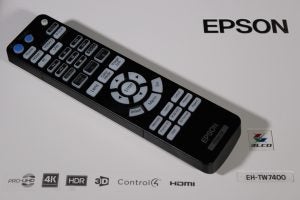
The remote control is fairly large, but fits comfortably in the hand and has all the buttons you’ll need. These are laid out in a sensible fashion and, most importantly, there’s a backlight, which is useful for controlling a projector primarily designed to be used in dedicated dark rooms.
Features
The Epson EH-TW7400 is feature-packed for a projector at any price, let alone an entry-level model, and is built around three 1080p LCD chips combined with a bulb that has a claimed brightness of 2400 lumens.
The lens controls are motorised and there’s also a lens memory function, allowing the creation of different aspect ratios for those using a 2.40:1 projection screen. It’s unusual to see a feature such as this on a sub-£2000 projector.
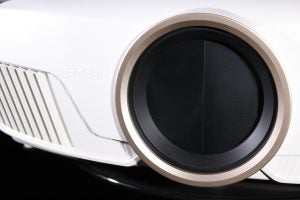
The EH-TW7400 includes what Epson calls “4K PRO-UHD”, which takes one image and then shifts a second image diagonally by half a pixel to create a single picture with a perceived resolution that’s higher than Full HD. What that basically means is that the projector can accept and display an Ultra HD signal, and while it isn’t native 4K, the image does look like it has a higher resolution.
The Epson also supports High Dynamic Range, allowing it to receive an HDR10 signal and benefit from brighter highlights, greater shadow detail, and more saturated colours. The EH-TW7400 also supports 3D, although if that’s still your thing then you’ll need to buy the glasses separately.
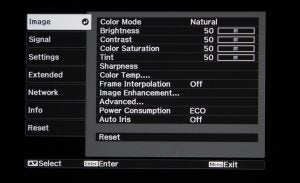
Other features include frame interpolation, allowing for smoother motion with sports, and an auto iris that can improve the contrast by opening the iris for bright scenes, and closing it down for darker ones. Since this projector is aimed at dedicated installations, there’s also a full set of calibration controls and support for Control 4, AMX and Crestron products.
Setup
Despite all these features the Epson EH-TW7400 is relatively easy to setup, although since it’s aimed at dedicated rooms, this projector is more likely to be permanently installed with a projection screen (fixed or motorised). You have a choice of placing it on a stand/shelf (there are adjustable feet to level the image), or mounting it from the ceiling using a bracket.
Once the projector has been installed, the motorised lens controls come in very handy, allowing users to quickly zoom, shift, and focus the image. For the best results, always try to ensure the projector’s lens is as close to the centre of the screen as possible. Never use the keystone control, because it will introduce scaling artefacts and rob the image of fine detail.
The menu system is fairly straightforward, and for the most accurate images choose the Natural Colour mode. The EH-TW7400 offers plenty of brightness so this should be ideal for watching content in a darkened room. However, if there’s a lot of ambient light then you might find the Bright Cinema mode more useful – and if you’re watching 3D, then go for the 3D Cinema mode.
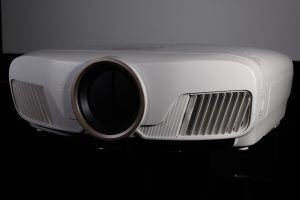
When it comes to HDR things aren’t quite as simple. First, there are no separate HDR modes; the projector just remains in the current mode and applies the correct HDR gamma curve. For the best results use the Cinema mode with HDR, because then the EH-TW7400 applies a filter to deliver all the saturated colours.
This filter does reduce the light output slightly, but Epson has included a number of tone-mapping settings to adjust the brightness. The Auto setting is the default, but if the image appears too dark then there’s also an Auto Bright option. In addition, you can play with four HDR presets that change the tone mapping, although the first two are the same as Auto and Auto Bright.
There’s a full set of calibration controls, so if you’re a professional or even a gifted amateur with the right equipment then you can get a very accurate image with both SDR and HDR content.
Auto Iris has two settings: Normal or High Speed. In testing they appeared to make no perceivable difference to the contrast performance, and you could also see and hear it in operation. It’s probably best left off, but feel free to experiment.
The frame interpolation feature is useful when watching sport, reducing blur and judder. However, it’s best to avoid it when watching movies and TV dramas – unless you want them to look like cheap video.
While the EH-TW7400 doesn’t have a dedicated game mode, that doesn’t really matter because the input lag measures at a very respectable 25ms. If you want to keep the input lag down, it’s best not to use the frame interpolation. This projector might be primarily aimed at movie fans, but it’s actually a great all-rounder that’s sure to please gamers and sports fans as well.
Performance
The Epson EH-TW7400 delivers an impressive performance right out of the box, with bright and punchy images that offer plenty of saturated colours. The standard dynamic range (SDR) pictures are detailed and nicely rendered, with an image that retains a pleasing level of accuracy. Colours are excellent, with natural skin tones, grass, skies and sunsets, for example.
The LCD panels are correctly aligned and free of any aberrations, resulting in a clean and uniform image with no geometry issues. The motion handling is exactly what you’d expect from a projector that uses LCD panels, with some blurring but no obvious judder. The frame interpolation feature can help when watching fast-paced sports, but is best left off for movies and TV dramas.
The projector may be aimed at dedicated home cinema installations, but it has sufficient brightness to be used in less-than-ideal environments – in rooms with white walls, for example. Sadly, the EH-TW7400’s weak spot is its ability to deliver deep blacks; instead, they appear more dark grey and there’s also limited detail in shadows.
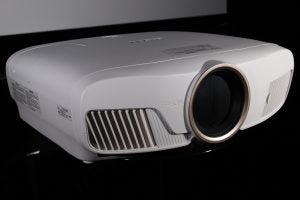
This isn’t surprising given the price, but the weak black levels mean the Epson is better suited to rooms with light-coloured walls, where the poor contrast won’t be adversely affected by reflected light. A projector with a really good contrast ratio would struggle in such an environment – but, conversely, this weakness in the EH-TW7400’s performance is more obvious in a blacked-out room.
The image processing is very good, and the projector can effectively upscale lower-resolution content when necessary. Epson’s “4K PRO UHD” feature also works well, allowing the projector to accept and display a 4K signal. The result isn’t quite as detailed as a native 4K projector, but that would cost at least three times as much, and from a distance it’s hard to distinguish the two.
The EH-TW7400 is fairly good at handling HDR content, but in reality all projectors struggle when it comes to the increased dynamic range. On the plus side, the colour gamut is wide enough to deliver all the saturation inherent in HDR content, and this is delivered with good accuracy. Since the black floor is already raised, this aspect isn’t adversely affected by the increased brightness of HDR.
Where the EH-TW7400 does have issues is in terms of tone mapping the dynamic range, and this is especially true with 4000-nit content. The tone mapping has to squeeze brighter peak highlights into a display that can only effectively deliver about 200 nits. This can result in the highlights losing detail, and the overall image appearing too dark.
A film such as The House with a Clock in Its Walls is a good example: it has a lot of dark scenes that will require you to adjust the HDR setting to get more detail out of the image. Conversely, brightly lit content such as Planet Earth II can often look stunning on the EH-TW7400. This projector isn’t the best HDR performer we’ve seen, but neither is it the worst.
Should you buy it?
If you’re after good accuracy Supporting both 4K and HDR, the EH-TW7400 delivers with a surprising level of accuracy. It includes a motorised lens cover, motorised lens controls and a lens memory, which you won’t find on any other projector at this price point. It also has an auto iris, frame interpolation, 3D support, and calibration controls, not to mention a very low input lag.
If you need better black levels The Epson’s colour picture performance is only marred by slightly ropey blacks and shadow detail – something of a disappointment in a home cinema projector
Final Thoughts
The Epson EH-TW7400 is the perfect example of how economies of scale can deliver a superior product at a competitive price. Epson has leveraged its dominance in data-grade projectors to deliver a home cinema model that not only includes features rarely seen at this end of the market, but a performance you wouldn’t necessarily get from a projector twice the price.








